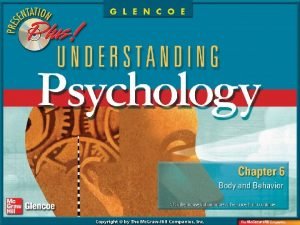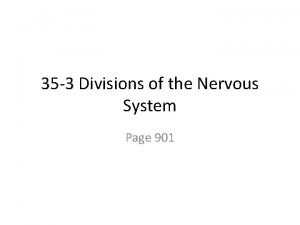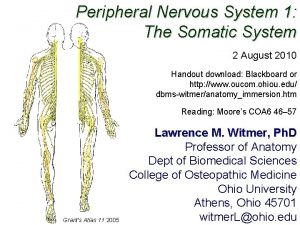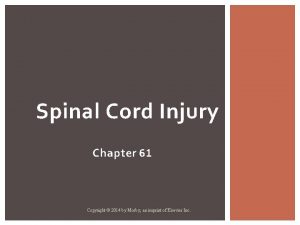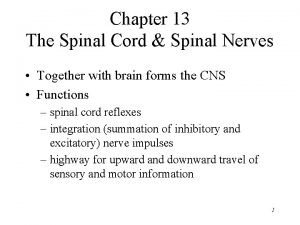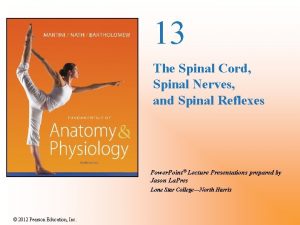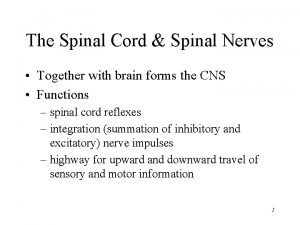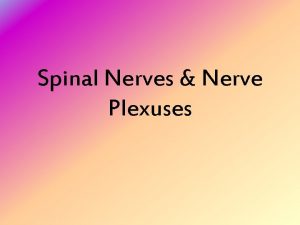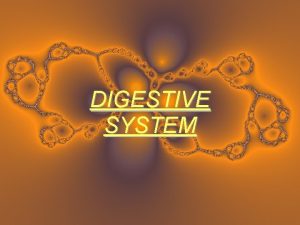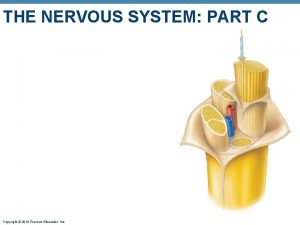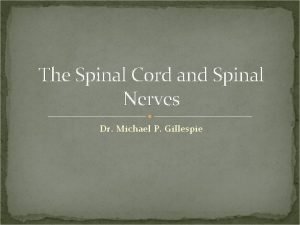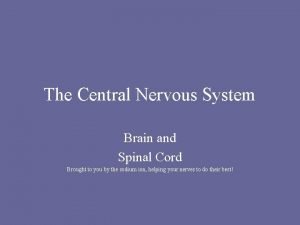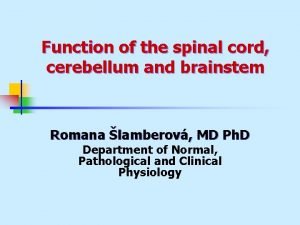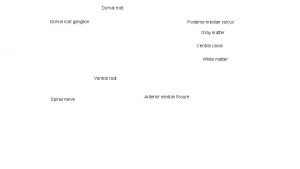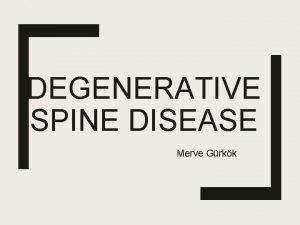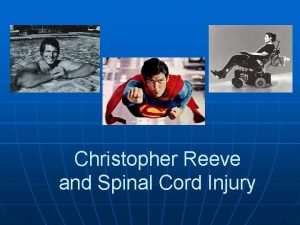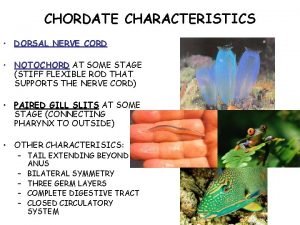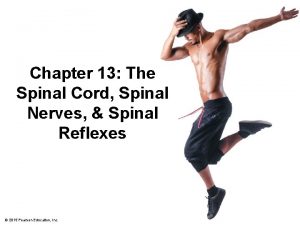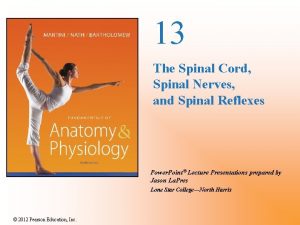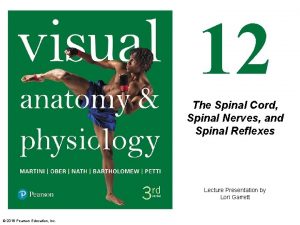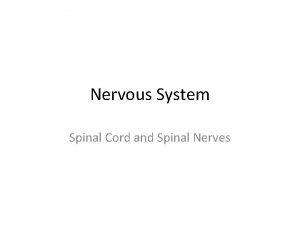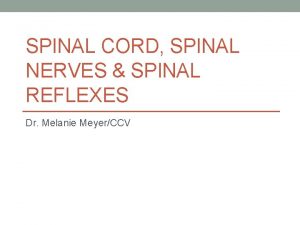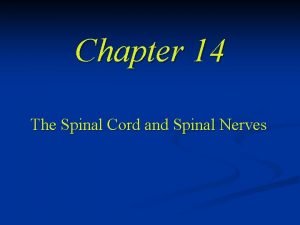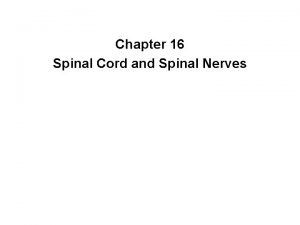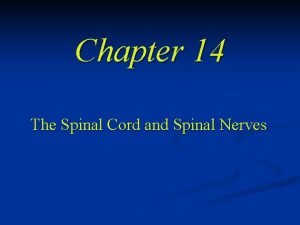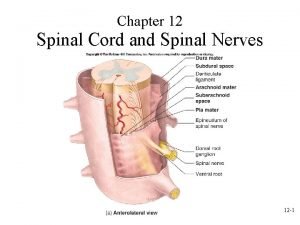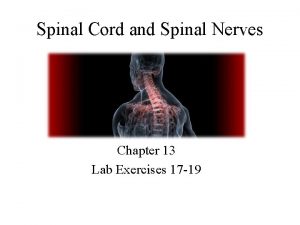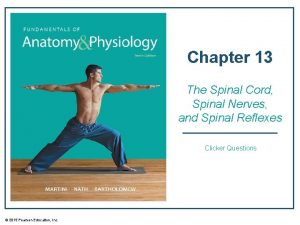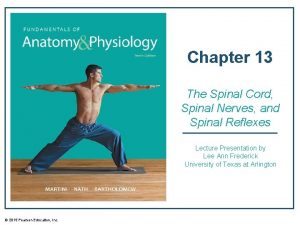1 Spinal Cord and Spinal Nerves 2 Chapter





























- Slides: 29

1

Spinal Cord and Spinal Nerves 2

Chapter 13 Spinal Cord and Spinal Nerves 3

Spinal Cord • Extends from foramen magnum to second lumbar vertebra • Segmented – – Cervical Thoracic Lumbar Sacral • Gives rise to 31 pairs of spinal nerves • Not uniform in diameter throughout length 4

Meninges • Connective tissue membranes surrounding spinal cord and brain – Dura mater – Arachnoid mater – Pia mater • Spaces – Epidural: Anesthesia injected – Subdural: Serous fluid – Subarachnoid: CSF 5

Cross Section of Spinal Cord 6

Cross Section of Spinal Cord • White matter • Myelinated axons forming nerve tracts • Fissure and sulcus • Three columns or funiculi – Ventral – Dorsal – Lateral • Gray matter • Neuron cell bodies, dendrites, axons • Horns – Posterior (dorsal) – Anterior (ventral) – Lateral • Commissures – Gray: Central canal – White 7

Reflex Arc • Basic functional unit of nervous system and simplest portion capable of receiving stimulus and producing response • Components – – – Sensory receptor Sensory neuron Interneurons Motor neuron Effector organ 8

Stretch Reflex • Muscles contract in response to a stretching force applied to them 9

Golgi Tendon Reflex • Prevents contracting muscles from applying excessive tension to tendons 10

Withdrawal Reflex • Function is to remove a body limb or other part from a painful stimulus 11

Withdrawal Reflex with Reciprocal Innervation • Causes relaxation of extensors muscle when flexor muscles contract 12

Withdrawal Reflex with Crossed Extensor Reflex • When a withdrawal reflex is initiated in one lower limb, the crossed extensor reflex causes extension of opposite lower limb 13

Peripheral Nerves • Consist of – Axon bundles – Schwann cells – Connective tissue • Endoneurium • Perineurium: Surrounds axon groups to form fascicles • Epineurium 14

Spinal Nerves 15

Dermatomal Map • Skin area supplied with sensory innervation by spinal nerves 16

Cervical Plexus • C 1 -C 4 • Phrenic nerve – From C 3 -C 5 cervical and brachial plexus – Innervate diaphragm 17

Brachial Plexus • C 5 -T 1 • Major nerves – – – Axillary Radial Musculocutaneous Ulnar Median 18

Axillary Nerve 19

Radial Nerve 20

Musculocutaneous Nerve 21

Ulnar Nerve 22

Median Nerve 23

Lumbosacral Plexus 24

Obturator Nerve 25

Femoral Nerve 26

Tibial Nerve 27

Fibular Nerve 28

PNS Disorders • General disorders – Anesthesia: Loss of sensation • • Hyperesthesia: Increased sensitivity to pain, pressure, light Paresthesia: Tingling, prickling, burning Neuralgia: Nerve inflammation causing stabbing pain Sciatica: Pain radiating down back of thigh and leg • Infections – Herpes: Skin lesions – Shingles or herpes zoster: Adult disease of chickenpox – Poliomyelitis: Infantile paralysis • Genetic and autoimmune disorders – Myasthenia gravis: Results in fatigue and muscular weakness due to inadequate ACh receptors 29
 Our old trusty truck cranial nerves
Our old trusty truck cranial nerves Exercise 15 spinal cord and spinal nerves
Exercise 15 spinal cord and spinal nerves Spinal cord and spinal nerves exercise 15
Spinal cord and spinal nerves exercise 15 Nerves branching beyond the spinal cord into the body
Nerves branching beyond the spinal cord into the body Epineurium
Epineurium Trachea and spinal cord
Trachea and spinal cord Spinal cord and brain
Spinal cord and brain Dermatome map
Dermatome map Somi brace
Somi brace Ganglion on spine
Ganglion on spine Somatic nervous system
Somatic nervous system Spinal cord covered by
Spinal cord covered by Lumbar spine nerve roots
Lumbar spine nerve roots Figure 13-2 spinal nerves
Figure 13-2 spinal nerves Spinal nerves
Spinal nerves Spinal segment
Spinal segment Spinal cord grooves
Spinal cord grooves Frog spinal nerves
Frog spinal nerves Site of somatic motor neuron cell bodies
Site of somatic motor neuron cell bodies Part of central nervous system
Part of central nervous system Components of nervous system
Components of nervous system Spinal cord denticulate ligament
Spinal cord denticulate ligament Spinal cord structures
Spinal cord structures Causes of spinal cord compression
Causes of spinal cord compression Anterior ramus of spinal cord
Anterior ramus of spinal cord Function of medulla
Function of medulla Posterior dorsal median sulcus
Posterior dorsal median sulcus Intervertebral disc prolapse
Intervertebral disc prolapse Christopher reeve spinal cord injury level
Christopher reeve spinal cord injury level Dorsal nerve cord notochord
Dorsal nerve cord notochord



